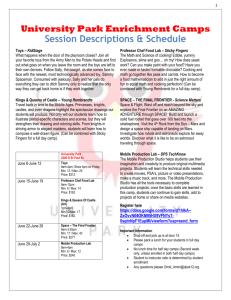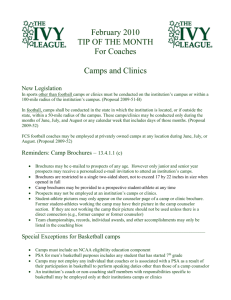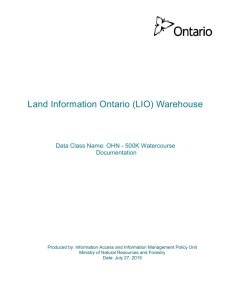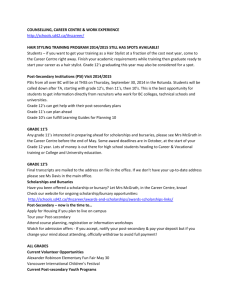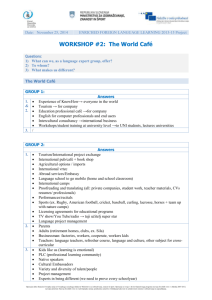2.2 The target population has access to hand wash facilities
advertisement
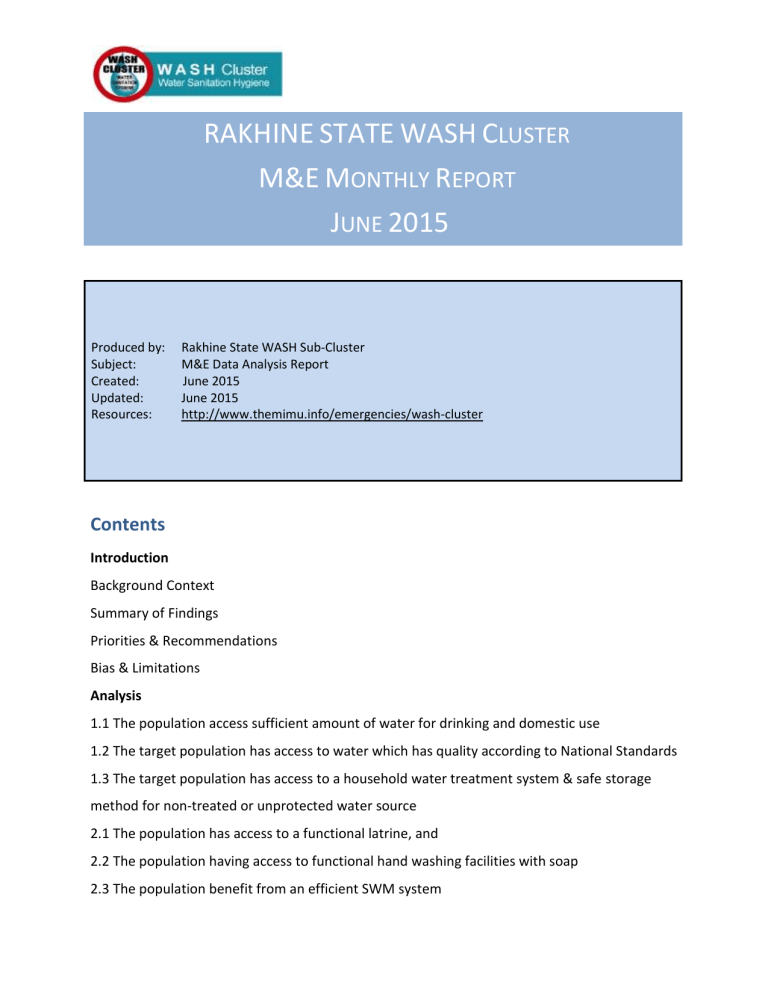
RAKHINE STATE WASH CLUSTER M&E MONTHLY REPORT JUNE 2015 Produced by: Subject: Created: Updated: Resources: Rakhine State WASH Sub-Cluster M&E Data Analysis Report June 2015 June 2015 http://www.themimu.info/emergencies/wash-cluster Contents Introduction Background Context Summary of Findings Priorities & Recommendations Bias & Limitations Analysis 1.1 The population access sufficient amount of water for drinking and domestic use 1.2 The target population has access to water which has quality according to National Standards 1.3 The target population has access to a household water treatment system & safe storage method for non-treated or unprotected water source 2.1 The population has access to a functional latrine, and 2.2 The population having access to functional hand washing facilities with soap 2.3 The population benefit from an efficient SWM system 2.4 The population benefits of an effective drainage system 3.1 target population has prevalence rate of diarrhea for >5yrs and <5yrs 3.2a sample population correctly interpret 3 good hygiene practices 3.2b sample population observed with 3 good hygiene practices 3.2c sample population has knowledge on the key times to wash hands 3.3a sample population of head of households practice effective HH water treatment method for drinking 3.3b sample population of head of households practice storing water correctly for drinking 3.4 sample household water in storage containers show no faecal contamination or FRC 0.20.5mg/l 3.5a respondents identify a safe place where they always defecate 3.5b excreta observed within the confines of the community 4.1 All TLS have minimum standard child friendly latrines and available water 4.2 segregated and safe access to WASH for disabled 4.3a Women are represented and participate in decisions affecting WASH service delivery 4.3b Safety and dignity through total privacy for men, women and children is provided through security at latrines 4.3c Safety and dignity for adolescent girls and women are prioritized through private access to menstrual hygiene facilities 4.3d Safety and dignity for adolescent girls and women are prioritized through private access to menstrual hygiene disposal facilities 5.1a User groups / committees are effective in maintaining water points facilities 5.1b User groups / committees are effective in maintaining latrines 5.2 Communities are effective in management of water points 5.3 community’s awareness of complaints mechanism Conclusion(s)/Discussion Conclusions (priorities/recommendations) Additional observations Emerging questions for subsequent Data Analysis Reports Relevant information / documents Introduction Background Context The Report is a monthly data analysis, and is a part of an M&E Strategy, that allows the Rakhine WASH Cluster to; provide a more qualitative data collection system to better measure the impact of the WASH interventions, track over time changes in the situation and evolving need, identify shortcomings, gaps, and lessons learned for future strategy development, facilitate upward and downward accountability between stakeholders, humanitarian actors, beneficiaries, donors, and government, Involve non-WASH actors and other camp focal points in monitoring the WASH services in order to create better community involvement in monitoring the situation in the IDP camps and villages. Each indicator of the M&E strategy is in most part graphically represented in the analysis section of this report, to include a direct and simple observation of the results, and where appropriate make reference to the following framing issues what gaps in service delivery stand out, what comparisons can be made, what can cross referencing tell us, what trends are developing, and, what performance adjustments have been made. Summary of Findings Priorities, recommendations and specific actions to take for infrastructure data collected from 68 sites; (30 camps and 38 villages). Data collected from villages was completed using a modified and different monitoring framework and criteria than for IDP camps. In this report, villages are compared with or analyzed alongside IDP camps, where appropriate for gaps in service delivery. 1. From the reported data, according to the criteria as set out by the WASH Cluster, measured against SPHERE access requirements, the WASH Cluster as a whole continues to provide more than sufficient quantities of water for the whole population. 2. The WASH Cluster is providing access to functional latrines for 46% of January 2015 and 75% in June 2015 of the monitored population in Sittwe area and in 5 camps out of 17, the recorded number of functioning latrines meet SPHERE requirements. This is an increase of 29% of population access functionality from January to June 2015. 3. In Sittwe 17 IDPs camps, Solid Waste management condition is improved. All of their scores fall in ineffective and satisfactory category. 4. WASH service deliveries at TLSs have improved gradually. Disabled access measured in terms of satisfaction, has not improved and still highly unsatisfactory. Menstrual hygiene management facilities largely do not exist; however, evidence has started to emerge of individual facilities being made specifically available for private bathing and disposal of san-pads in one camp. Priorities & Recommendations The priorities in order of most significance are; Latrine new construction and maintenance especially need in Ohn Taw Gyi South and Phwe Yar Gone camps Equitable and Safe Access to WASH for children, disabled and women Proper drainage system especially need in Set Yoe Kya 1 and 2 camps Recommendations are; Improve access to functional latrines by improving the condition of the latrines, specifically ensure superstructures provide privacy and security when being used, and that parts are replaced such as broken pans, pipe connections, vent pipes and inspection lids. Continue to improve access to WASH for children by providing adequate WASH facilities for children at TLSs, specifically a minimum of one latrine for girls and one latrine for boys to cover learning shifts for up to 80 children at a time. Consider adolescent girls and women’s hygiene in future programming. New relocation sites need household latrines. Spare parts for the ceramic water filter need to be replaced. There is a gap of WASH focal agencies in Mrauk-U and Minbya townships since January 2015 up to present. Locally appropriate village approach is needed to be applied outside Sittwe townships especially in relocation places. Solar lamps were installed in latrine area of some camps, so children and women have safety access to latrines at night time. Bias and Limitations From September 2014, the same content and methodology was used during all training of CCCM partners involved in collecting data. The training was facilitated separately to each partner. An updated solid waste management methodology and tool was introduced during training to better measure levels of litter waste. In general, the tool comprises the scoring of litter seen throughout several different areas of the camp or village. In October 2014, some interpretation of one of the five criteria for latrine functionality was found to be inconsistent with other known interpretations of the same criteria. Specifically, this related to the inspection of the latrine using the latrine inspection tool, which asks the field inspector to assess whether,…[the], “LATRINE IS NOT FULL AND OVERFLOWING AT THE PAN AND/OR THE SEPTIC TANK (Y/N)” The interpretation of this can be ambiguous, as in when reporting ‘Y’, it can imply that, “Yes there is not a problem”, or when reporting ‘N’, it can imply that, “No, there is not a problem”. For the reporting of October onwards, field monitor’s interpretation of the data was doublechecked, but there was enough sufficient error potential to dismiss the latrine data in whole as unreliable at that time, but still provided enough evidence to raise latrine standards as being a significant issue. To ensure more reliable consistency in November’s monitoring, a ‘review’ workshop was held for all field monitors from the different CCCM partners at the same venue and same time, to correct, or reassert a consistent interpretation of all indicators, criteria, methodology and tools. Assuming the outputs of the review were a consistent understanding and interpretation of the tools and reporting, the field monitors responsible for collecting raw data, then had to re-state those interpretations to IDP volunteers involved in the collection of data. To this end, November’s raw data was considered to provide the best snapshot of infrastructure data so far, and no further reviews have taken place since November. Some infrastructure inspection sample sizes are occasionally smaller or larger than stipulated by the methodology. Plus / minus variations in results between October and November were attributed to this factor. When comparing present data against previous month’s data, there are often small percentage differences of approximately 1%. Analysis was taken in November for the first time from the DFID consortium KAP Survey data from mid-2014. The data from the KAP survey was interpreted to the methodology specific to WASH M&E Cluster indicators, not as per the DFID consortium methodology for data analysis. Where this data is used in this report and subsequent reports to cross reference with other indicators, the raw data is to be considered data from mid-2014, until a new KAP Survey or hygiene monitoring tool is introduced. Water quality data and diarrhea tracking data was reported in full for January’s monthly report. Analysis Townships Summary of WASH Conditions in villages 100% 100% 100%100% 88% 90% 80% 70% 60% 60% 50% 42% 35% 25% 39% 40% 30% 21% 20% 25% 6% 10% 19% 13% 11% 8% 0% 39% 29% 31% 7% 0% Kyauk Phyu Kyauk Taw 10 Villages 6 Villages Minbya Mrauk-U 5 Villages 3 Villages Ponna Gyun Rathedaung 7 Villages 19 Villages Sittwe 9 Villages % of population coverage function water points % of Pop Covarage of functioning Latrine % of Learning institute meeting full WASH criteria for children's access The average coverage of water points in each township does not meet 100% except in Kyauk Phyu and Ponna Gyun Townships. Water coverage of those townships were updated only for June, so the water coverage of these two townships show 100%. Out of the Sittwe area, most of the water points are ponds and the criteria of pond is that one pond can cover for 500 population. The coverage of functioning latrines in villages is less than 50% in all townships. In 13 villages in Rathedaung and Ponna Gyun townships, CLTS approach has been implemented by IRC and the project targets 100% of households in the end of their project. So the latrine coverage of Ponna Gyun and Rathedaung townships was still low. In other townships, latrine construction was supported by WASH agencies. WASH coverage of learning institutes in Mrauk_U has been 0%, those in Kyauk Taw, Minbya, Rathedaung and Sittwe townships has been lower than 50%, Kyauk Phyu has reached to 88 % in June and Ponna Gyun township meets 100%. LWF and PLAN are starting to implement WASH facilities at learning institutes in Mrauk-U and Minbya townships. When they finish their activities, the coverage of WASH facilities in learning institutes will increase. % of Population Coverage Functioning Water Points 100% 100% 100% 74% 39% 50% 0% 0% 37% 30% 29% 0% 0% 43% 36% 0% 0% Water Coverage Muslim Water Coverage Rakhine 0% of water coverage in both communities means no implementation of water points renovation or new construction. % of Population Coverage Functioning Latrines 50% 44% 41% 44% 40% 30% 21% 20% 10% 0% 6% 0% 11% 6% 0% 19% 14% 7% 0% 0% Latrine Coverage Muslim Latrine Coverage Rakhine 0% of latrine coverage in both communities means no implementation of sanitation activities. Latrine coverage in all townships is less than 50%. % of Learning Institute (LI) meeting full WASH criteria for children's access 100% 100% 88% 80% 60% 40% 20% 33% 25% 0% 0% 13% 0% 20% 0%0% 33% 25% 0% 0% LI Coverage Muslim LI Coverage Rakhine WASH Conditions in Camps 1.1 The total required water supply is functional allowing the population to access to 15 liters /person/day for the total population Sittwe IDPs Camps The access for functioning water point’s water supply in Sittwe Townships IDP camps has consistently been reported as meet 100% cover of the population according to the cluster M&E standard in May 2015, and access is not considered as a problem in the Sittwe area. 1.1 The total required water supply is functional allowing the population to access to 15 liters /person/day for the total population Other Townships IDPs Camps 100% 90% 80% 70% 60% 50% 40% 30% 20% 10% 0% Jan Yai-Thei-Thi Kyar Ward 6 Taung Paw Sin Tet Maw(IDP in Shelter) Set Yone Maw Raw Ma Ni Sin Oe Pha Yar Gyi Kwin Ni Din Kyein Ni Pyin Kyauk Ta Lone Kan Thar Htwat Wa Chait Taung - Tha Dar Chait Taung - San Htoe Tan Feb Mar Apr May June % of population coverage function water points In the camps outside Sittwe area, water availability is not mainly focused on the quality of water and mainly on the access of water. The methodology was modified for the ponds and wells, and it mainly measures whether the water supply is covered for the whole village or not. 1.2 The target population has access to water which has quality according to National Standards October to December 2014 - % of sample per site with 0 FC 50,0 % 45,0 % 40,0 % 35,0 % 30,0 % 25,0 % 20,0 % 15,0 % 10,0 % 5,0 % 0,0 % A Nauk Ywe Ah Du Ah Htet Nan Yar Ah Nauk Pyin Basara Baw Du Pha Baw Du Pha… Chein Khar Li Chut Pyin Dar Pai Dar Paing Village Daung Pyauk Kay Doe Wai Chaung Kaung Doke… Koe Tan Kauk Maw Ti Ngar… Nget Chaung Ohn Taw Gyi… Sin Tet Maw… Sin Tet… Sin Tet… Thea Chaung Thea Chaung… Thea Chaung… Thet Kel Pyin Thet Kel Pyin… Zaw Pu Gyar 2014 Data In approximately half of the sites where FC presence in raw water sources is measured, none of the sources reaches national standards. In the remaining sites, between 8% to 43% of the samples tested achieve the national standard. 1.3 The target population has access to a household water treatment system & safe storage method for non-treated or unprotected water sources October to December 2014 - % of sample HH per site with households using treatment system 2014 Data 100% 80% 60% 40% 20% 0% 2014 Data Although recent distributions of CWF had occurred in the villages where sample households were inspected, there were significant numbers of households not using them for varying reasons, i.e. broken, not received during distribution, etc. 2.1 The total required functional latrines are available for men, women and children Sittwe IDPs Camps - % of Population coverage of functioning latrine (according to SPHERE access) In Sittwe IDPs camps, latrines are reported to be enough for the IDP population according to the SPHERE standard but most of them are not functioning due to maintenance issues. Most of non-functioning latrines either do not have vent pipes, broken connection pipes, missing inspection lids and unsafe flooring. The average access to functional latrines for each camp in 6 months is shown below: Jan Feb Mar Apr May latrine is less than 50%. So the agencies should focus on the access latrine. Thet Kel Pyin (IDP in shelter) Thea Chaung Set Yone Su 3 Set Yone Su 1 Say Tha Mar Gyi Sat Roe Kya 2 Sat Roe Kya 1 Phwe Yar Gone Ohn Taw Gyi South Ohn Taw Gyi North Ohn Taw Chay Maw Ti Ngar (TKP west) Kaung Doke Khar 2 (Hmansi) Kaung Doke Khar 1(excl.Hmanzi) Dar Pai Baw Du Pha Basara 100% 90% 80% 70% 60% 50% 40% 30% 20% 10% 0% % of Pop Covarage of functioning Latrine June During 6 months, Ohn Taw Gyi South and Phwe Yar Gone camps, the population coverage of 120% 100% 80% 60% 40% 20% Thet Kel Pyin (IDP in shelter) Thea Chaung Set Yone Su 3 Set Yone Su 1 Say Tha Mar Gyi Sat Roe Kya 2 Sat Roe Kya 1 Phwe Yar Gone Ohn Taw Gyi South Ohn Taw Gyi North Ohn Taw Chay Maw Ti Ngar (TKP west) Kaung Doke Khar 1(excl.Hmanzi) Kaung Doke Khar 2 (Hmansi) Dar Pai Baw Du Pha Basara 0% % of Pop Covarage of functioning Latrine Average Jan'15 to May'15 Average Jan'15 to June'15 In Sittwe township, there are 3 camps in which 100% of the camp population meets functioning latrines within 6 months from January to June 2015. The camp population meets less than 50% of the functioning latrines in 6 camps and in the rest camps, the population coverage of functioning latrines is over 50%. In 11 camps, latrine coverage increases in June. 2.1 The total required functional latrines are available for men, women and children Other Townships IDPs Camps - % of Population coverage of functioning latrine (according to SPHERE access) In June, WASH agencies in other townships two IDP camps only updated the coverage of latrine. Yai-Thei-Thi Kyar Ward 6 Taung Paw Sin Tet Maw(IDP in Shelter) Set Yone Maw Raw Ma Ni Sin Oe Pha Yar Gyi Kwin Ni Din Kyein Ni Pyin Kyauk Ta Lone Kan Thar Htwat Wa Chait Taung - Tha Dar Chait Taung - San Htoe Tan 100% 90% 80% 70% 60% 50% 40% 30% 20% 10% 0% % of Pop Covarage of functioning Latrine Jan Feb Mar Apr May June In townships out of Sittwe area, there is only one camp in which 100% of the camp population meets functioning latrines in June 2015. In another one camp, over 50% of the camp population meets functioning latrines and in the rest camps, less than 50% of the camp population meets functioning latrines. According to the Government relocation in outside Sittwe area, the Government is starting to construct the individual shelters and the community will need individual latrines but the Government has no plan to support the WASH facilities. % of Pop Covarage Latrine with hand washing points Jan Feb Mar Apr May June Thet Kel Pyin (IDP… Thea Chaung Set Yone Su 3 Set Yone Su 1 Say Tha Mar Gyi Sat Roe Kya 2 Sat Roe Kya 1 Phwe Yar Gone Ohn Taw Gyi South Ohn Taw Gyi North Ohn Taw Chay Maw Ti Ngar (TKP… Kaung Doke Khar… Dar Pai Baw Du Pha Basara 100% 90% 80% 70% 60% 50% 40% 30% 20% 10% 0% Kaung Doke Khar… 2.2 The target population has access to hand washing facilities with water with soap Sittwe IDPs Camps There are 3 camps out of 17 in Sittwe township which have 100% of the population access to hand washing facilities in June 2015. In another 3 camps, population coverage of latrines with hand washing facilities is more than 50% and in all the rest camp, that is less than 50% in June 2015. Although there is no public functioning hand washing facilities near the latrines in the camps, some of the community has hand washing practice in their shelters. 2.2 The target population has access to hand wash facilities with water with soap Other Townships IDPs Camps Yai-Thei-Thi Kyar Ward 6 Taung Paw Sin Tet Maw(IDP in Shelter) Set Yone Maw Raw Ma Ni Sin Oe Pha Yar Gyi Kwin Ni Din Kyein Ni Pyin Kyauk Ta Lone Kan Thar Htwat Wa Chait Taung - Tha Dar Chait Taung - San Htoe Tan 100% 90% 80% 70% 60% 50% 40% 30% 20% 10% 0% % of Pop Covarage Latrine with hand washing points Jan Feb Mar Apr May June The functioning hand washing facilities in out of Sittwe area are very low; only 5 camps have the hand washing facilities. 2.3 The target population has access to an effective SWM system Sittwe IDPs Camps - Effective Waste Management System scoring 0,5,10,15 in IDP camps Thet Kel Pyin (IDP… Thea Chaung Set Yone Su 3 Set Yone Su 1 Say Tha Mar Gyi Sat Roe Kya 2 Sat Roe Kya 1 Phwe Yar Gone Ohn Taw Gyi South Ohn Taw Gyi North Ohn Taw Chay Maw Ti Ngar (TKP… Kaung Doke Khar 2… Kaung Doke Khar… Dar Pai Baw Du Pha Basara 80 70 60 50 40 30 20 10 0 2.3 Condition Result (0 = Excellent, 35< Effective,70< Satisfactory, 70 < Ineffective) Jan Feb Mar Apr May June Only 5 camps out of 17 reported effective SWM (scored <35), only one camps is ineffective SWM (scored > 70), and the remaining camps fell in the ‘satisfactory SWM’ category (scored >35 <70). Ohn Taw Chay camp scored more than 70 (Ineffective condition) in February and May. There is no camp that scores “0” (Excellent condition) during the 6 months period from January to June 2015. 2.3 The target population has access to an effective SWM system Other Townships IDPs Camps - Effective Waste Management System scoring 0,5,10,15 in IDP Camps 2.3 Condition Result (0 = Excellent, 35< Effective,70< Satisfactory, 70 < Ineffective) Jan Feb Mar Apr May June Yai-Thei-Thi Kyar Ward 6 Taung Paw Sin Tet Maw(IDP in Shelter) Set Yone Maw Raw Ma Ni Sin Oe Pha Yar Gyi Kwin Ni Din Kyein Ni Pyin Kyauk Ta Lone Kan Thar Htwat Wa Chait Taung - Tha Dar Chait Taung - San Htoe Tan 70 60 50 40 30 20 10 0 Solid waste management is satisfactory or effective in camps outside of Sittwe. Only two camps was updated in June. 2.4 The target population benefits from an efficient drainage in the site Only two camps in Sittwe area, Thet Kel Pyin and Maw Ti Nyar camps, have no drainage issue. The rest camps have drainage issues. 3.1 Self-reported diarrhea is reduced for >5yrs and >5yrs Weekly Prevalence from three Partners - total of 13 sites % reduction / increase <5s May Basara Baw Du Pha Chait Taung - San Htoe Tan Chait Taung - Tha Dar Dar Pai Kan Thar Htwat Wa Kaung Doke Khar… Kaung Doke Khar 2… Kyauk Ta Lone Kyein Ni Pyin Maw Ti Ngar (TKP west) Ni Din Ohn Taw Chay Ohn Taw Gyi North Ohn Taw Gyi South Pha Yar Gyi Kwin Phwe Yar Gone Raw Ma Ni Sin Oe Sat Roe Kya 1 Sat Roe Kya 2 Say Tha Mar Gyi Set Yone Maw Set Yone Su 1 Set Yone Su 3 Sin Tet Maw(IDP in… Taung Paw Thea Chaung Thet Kel Pyin (IDP in… Ward 6 Yai-Thei-Thi Kyar 40% 35% 30% 25% 20% 15% 10% 5% 0% Diarrhoea tracking of <5 yrs Apr Mar Feb Jan % reduction / increase >5s May Basara Baw Du Pha Chait Taung - San… Chait Taung - Tha Dar Dar Pai Kan Thar Htwat Wa Kaung Doke Khar… Kaung Doke Khar 2… Kyauk Ta Lone Kyein Ni Pyin Maw Ti Ngar (TKP… Ni Din Ohn Taw Chay Ohn Taw Gyi North Ohn Taw Gyi South Pha Yar Gyi Kwin Phwe Yar Gone Raw Ma Ni Sin Oe Sat Roe Kya 1 Sat Roe Kya 2 Say Tha Mar Gyi Set Yone Maw Set Yone Su 1 Set Yone Su 3 Sin Tet Maw(IDP in… Taung Paw Thea Chaung Thet Kel Pyin (IDP in… Ward 6 Yai-Thei-Thi Kyar 40% 35% 30% 25% 20% 15% 10% 5% 0% Apr Mar Feb Jan Diarrhoea tracking of >5 yrs The tracking of reported diarrhea shows from January to June 2015, diarrhea prevalence data from WASH partners. *MICS (multi-indicator survey) 2009-2010, showed the national average prevalence rate for Myanmar is 6.7%. Rhakine State average prevalence rate showed as 8%. 3.2a Men, women and children (>7yrs) have basic knowledge of diarrheal disease transmission and prevention 3.2b good hygiene is practiced and observed in all households 3.2c Men, women and children have knowledge on key times for washing hands 3.3a All adults practice treatment of water to reduce contamination 3.3bAll adults practice protection of treated water to prevent contamination. Hygiene behaviour change indicators derived from KAP surveys 2014, from 24 sites 100% 80% 60% 40% 3.2a 3.2b 3.2c 3.3a Zaw Pu Gyar Ward 6 Thin Pone Tan Thet Kel Pyin Thea Chaung Village_R Thea Chaung Village_M Thea Chaung Say Tha Mar Gyi Pha Yar Gyi Kwin Ohn Taw Gyi South Ohn Taw Gyi North Nga/ Pun Ywar Shey Nga/ Pun Ywar Gyi Me la zi Kone Kyauk Ta Lone Daung Pyauk Kay Dar Paing Village Dar Pai Baw Du Pha Village Baw Du Pha Basara Aung Daing Ah lar Than 0% Thet Kel Pyin (IDP in… 20% 3.3b From KAP Survey data in mid-2014, basic knowledge of transmission and prevention is lower than the target as set out in the M&E strategy. The Sittwe camps and villages tend to show higher observed good hygiene practice in households, and approximately half of men, women and children know the key times for washing hands. The practice of treatment of water in Sittwe villages and camps is shown to be much lower than in Kyauk Phyu and Ramree. Protection of drinking storage water is above 80% in IDP camps, and 63% in Sittwe villages. 3.4 the water quality of household drinking storage has no faecal contamination October to December 2014 - % of sample HH per site with 0 FC Not recorded for May 2015 200 180 160 140 120 100 80 60 40 20 0 Jan Feb Mar Apr May June 3.5b # of shit observed in targetted sample area Thet Kel Pyin (IDP in… Thea Chaung Set Yone Su 3 Set Yone Su 1 Say Tha Mar Gyi Sat Roe Kya 2 Sat Roe Kya 1 Phwe Yar Gone Ohn Taw Gyi South Ohn Taw Gyi North Ohn Taw Chay Maw Ti Ngar (TKP… Zaw Pu Gyar Ward 6 Thin Pone Tan Thet Kel Pyin… Thet Kel Pyin Thea Chaung… Thea Chaung… Thea Chaung Say Tha Mar Gyi Pha Yar Gyi… Ohn Taw Gyi… Ohn Taw Gyi… Nga/ Pun Ywar… Nga/ Pun Ywar… Me la zi Kone Kyauk Ta Lone Dar Paing Village Dar Pai Baw Du Pha… Baw Du Pha Basara Aung Daing Ah lar Than 100% 80% 60% 40% 20% 0% Kaung Doke Khar 2… Kaung Doke Khar… Dar Pai Baw Du Pha Basara 3.5a % of Population coverage latrine usage Taken from KAP Survey 2014 % of Population coverage latrine usage % of Population coverage latrine usage 3.5b the community has minimized open defecation. Sittwe IDPs Camps - # of shit observed in the open In this month, 7 IDP camps in Sittwe township reported “0” open defecation, so there are 5 IDP locations in Sittwe area that are open defecation free from January to June 2015. The number of open defecation is high in Phwe Yar Gone camp because the sample area is also wide and need to get accurate information for the sample area. 3.5b the community has minimized open defecation. Other Townships IDPs Camps - # of shit observed in the open Yai-Thei-Thi Kyar Ward 6 Taung Paw Sin Tet Maw(IDP in Shelter) Set Yone Maw Raw Ma Ni Sin Oe Pha Yar Gyi Kwin Ni Din Kyein Ni Pyin Kyauk Ta Lone Kan Thar Htwat Wa Chait Taung - Tha Dar Chait Taung - San Htoe Tan 35 30 25 20 15 10 5 0 3.5b # of shit observed in targetted sample area Jan Feb Mar Apr May June Only two camps reported data of open defecation for this month and both of these camps are “0” OD. There are 3 IDP locations outside of Sittwe area that are open defecation free in consecutive 3 months. The number of open defecation is high in Kyein Ni Pyin camp, Pauk Taw township. 4.1 Total TLS with child friendly latrines and water points Sittwe IDPs Camps - % of children access to TLS WASH services Thet Kel Pyin (IDP in… Thea Chaung Set Yone Su 3 Set Yone Su 1 Say Tha Mar Gyi Sat Roe Kya 2 Sat Roe Kya 1 Phwe Yar Gone Ohn Taw Gyi South Ohn Taw Gyi North Ohn Taw Chay Maw Ti Ngar (TKP west) Kaung Doke Khar 2… Kaung Doke Khar… Dar Pai Baw Du Pha Basara 100% 90% 80% 70% 60% 50% 40% 30% 20% 10% 0% TLS TLS TLS TLS TLS TLS TLS TLS TLS TLS TLS TLS TLS TLS TLS TLS TLS 3 12 6 4 4 1 6 13 4 2 1 1 8 0 0 5 6 4.1 # of TLS meeting full WASH criteria for children's access Jan Feb Mar Apr May June TLS in 7 IDPs camps of Sittwe area have 100 % access to WASH services in June 2015. TLS in Dar Pai, Set Yoe Kya 1 and 2 camps do not meet the criteria of water and sanitation facilities from January to June 2015. There is no TLS in Set Yone Su 1 and 3 camps, so the percentage of WASH coverage in TLS is 0%. 4.1 Total TLS with child friendly latrines and water points Other Townships IDPs Camps % of children access to TLS WASH services Chait Taung - San Htoe Tan Chait Taung - Tha Dar Kan Thar Htwat Wa Kyauk Ta Lone Kyein Ni Pyin Ni Din Pha Yar Gyi Kwin Raw Ma Ni Sin Oe Set Yone Maw Sin Tet Maw(IDP in Shelter) Taung Paw Ward 6 Yai-Thei-Thi Kyar 100% 90% 80% 70% 60% 50% 40% 30% 20% 10% 0% TLS TLS TLS TLS TLS TLS TLS TLS TLS TLS TLS TLS TLS 1 2 0 1 4 2 0 1 1 2 6 1 1 4.1 # of TLS meeting full WASH criteria for children's access Jan Feb Mar Apr May June TLSs in 12 camps of outside Sittwe area meet 100% WASH facilities in June 2015. There is only one camp that does not have TLS at all, so the percentage of WASH coverage in TLS is 0%. 4.2 unique needs are addressed for persons with physical disability for access to specific WASH % of physical disable persons interviewees satisfied their WASH facilities Jan Feb Mar Apr May June Thet Kel Pyin (IDP… Thea Chaung Set Yone Su 3 Set Yone Su 1 Say Tha Mar Gyi Sat Roe Kya 2 Sat Roe Kya 1 Phwe Yar Gone Ohn Taw Gyi South Ohn Taw Gyi North Ohn Taw Chay Maw Ti Ngar (TKP… Kaung Doke Khar 2… Dar Pai Baw Du Pha Basara 100% 90% 80% 70% 60% 50% 40% 30% 20% 10% 0% Kaung Doke Khar… Sittwe IDP Camps -% of sample disable interviewees satisfied with WASH access Disable person interview was done in only 3 camps for this month. In Khaung Doke Khar 2 camps, 3 disable persons was interviewed and all are satisfied. 4.3a Women are represented and participate in decisions affecting WASH service delivery Thet Kel Pyin (IDP… Thea Chaung Set Yone Su 3 Set Yone Su 1 Say Tha Mar Gyi Sat Roe Kya 2 Sat Roe Kya 1 Phwe Yar Gone Ohn Taw Gyi South Ohn Taw Gyi North Ohn Taw Chay Maw Ti Ngar (TKP… Kaung Doke Khar 2… Dar Pai Baw Du Pha Basara 70% 60% 50% 40% 30% 20% 10% 0% Kaung Doke Khar… Sittwe IDPs Camps - % of women attending, initiating and responding in WASH meetings % of female present Jan Feb Mar Apr May June % of Female initiated WASH issue Jan Feb Mar Apr May June Thet Kel Pyin (IDP… Thea Chaung Set Yone Su 3 Set Yone Su 1 Say Tha Mar Gyi Sat Roe Kya 2 Sat Roe Kya 1 Phwe Yar Gone Ohn Taw Gyi South Ohn Taw Gyi North Ohn Taw Chay Maw Ti Ngar (TKP… Kaung Doke Khar 2… Dar Pai Baw Du Pha Basara 250% 200% 150% 100% 50% 0% Kaung Doke Khar… 0% of female present in 7 camps means there is no female member in WASH committee. The remaining camps have represented female members in WASH committees, but their initiatives and responses of WASH issues were still low. Jan Feb Mar Apr % of female present May June Yai-Thei-Thi Kyar Ward 6 Taung Paw Sin Tet Maw(IDP in Shelter) May Set Yone Maw Apr Raw Ma Ni Sin Oe Mar Pha Yar Gyi Kwin Feb Ni Din Jan Kyein Ni Pyin Kyauk Ta Lone Kan Thar Htwat Wa Chait Taung - Tha Dar Chait Taung - San Htoe Tan Thet Kel Pyin (IDP in… Thea Chaung Set Yone Su 3 Set Yone Su 1 Say Tha Mar Gyi Sat Roe Kya 2 Sat Roe Kya 1 Phwe Yar Gone Ohn Taw Gyi South Ohn Taw Gyi North Ohn Taw Chay Maw Ti Ngar (TKP… Kaung Doke Khar 2… Kaung Doke Khar… Dar Pai Baw Du Pha Basara 100% 90% 80% 70% 60% 50% 40% 30% 20% 10% 0% % of Female response June 4.3a Women are represented and participate in decisions affecting WASH service delivery Other Township IDP Camps - % of women represented in Camp, WASH, NGO group / committees 100% 90% 80% 70% 60% 50% 40% 30% 20% 10% 0% Participation is not measured in villages, and only representation is measured through reported numbers of women from government administration, user groups and NGO volunteers. 4.3b Safety and dignity through total privacy for men, women and children is provided through security at latrines Thet Kel Pyin… Thea Chaung Set Yone Su 3 Set Yone Su 1 Say Tha Mar Gyi Sat Roe Kya 2 Sat Roe Kya 1 Phwe Yar Gone Ohn Taw Gyi South Ohn Taw Gyi North Ohn Taw Chay Maw Ti Ngar… Kaung Doke Khar… Dar Pai Baw Du Pha Basara 100% 90% 80% 70% 60% 50% 40% 30% 20% 10% 0% Kaung Doke Khar… Sittwe IDPs Camps - % of latrines that provide total privacy and internal locking % of Pop Covarage Latrine privacy for user Jan Feb Mar Apr May June 100% of the population in 8 camps of Sittwe area have access to the secure and private latrines, more than 50% of the population in 4 camps have access to secure and private latrines and less than 50% of the population in the rest 5 camps have access to secure and private latrines in June 2015. The main reason for the unsecure latrines is unable to lock inside. 4.3b Safety and dignity through total privacy for men, women and children is provided through security at latrines Other Townships IDPs Camps - % of latrines that provided total privacy and internal locking Yai-Thei-Thi Kyar Ward 6 Taung Paw Sin Tet Maw(IDP in Shelter) Set Yone Maw Raw Ma Ni Sin Oe Pha Yar Gyi Kwin Ni Din Kyein Ni Pyin Kyauk Ta Lone Kan Thar Htwat Wa Chait Taung - Tha Dar Chait Taung - San Htoe Tan 100% 90% 80% 70% 60% 50% 40% 30% 20% 10% 0% % of Pop Covarage Latrine privacy for user Jan Feb Mar Apr May June There is only one camp outside Sittwe area in which the camp population has 100% access to private and secure latrines in June 2015. There is an inconsistent provision of privacy and security provided at latrines in IDP camps outside of Sittwe. The data of private and secure latrines was collected in only two camps for this month. 4.3c Safety and dignity for adolescent girls and women are prioritized through private access to menstrual hygiene facilities Sittwe IDP Camps - adolescent girls and women have access to private bathing, appropriate laundry (if no sanitary pads available) and appropriate disposal/ private drying facilities. Individual bathing facilities were constructed by the WASH agencies in some camps of Sittwe area and are started to use. 4.3d Safety and dignity for adolescent girls and women are prioritized through private access to menstrual hygiene disposal facilities Some camps have the communal dust bin and incinerator provided by the WASH agencies, but these are not specific for the menstrual hygiene disposal facilities. 5.1a User groups / committees are effective in maintaining water points facilities 5.1b User groups / committees are effective in maintaining latrines The non-incentive voluntary service of maintaining water points and latrines is still weak. In some camps, the maintenance of water points and latrines depends on the WASH agencies. Conclusions / Discussion Water quantity is not a concern, although quality of water is generally not to National standard Low scoring latrine functionality, or low percentages of meeting WASH criteria standards for latrines and availability of hand wash facilities is a significant concern Open defecation exists, but there are camps that record no evidence of open defecation There is low reported prevalence of diarrhea in three townships, which is a stable reporting period of 5-6 months. TLS WASH facilities are inadequate but improving slowly, however, disabled access is largely not satisfactory according to those disabled people who are interviewed. Community ownership is difficult to analyse, however, there are indications of WASH related meetings being held, and there is evidence that communities will maintain water points without the need for contractors or agency repair strategies, if given the materials and/or tools resources to do it. Relocation was taking place in Kyauk Taw, Mrauk-U, Minbya, Pauk Taw, Myebon and Rathaetaung Townships. Additional observations Whilst water quantity is not seen as a concern, there are sufficient numbers of repairable hand pumps to warrant considering a WASH Cluster maintenance or repair strategy, that would improve community ownership of water points in IDP camps. It has been seen during monitoring, that IDPs can repair hand pumps if given the tools and the materials. This can be an opportunity for WASH partners to increase community ownership of infrastructure within IDP camps. Throughout the monitoring experience, and development of a M&E village criteria, it has become apparent that a 3rd indicator was necessary for villages where mostly unprotected water sources require treatment, and this will be proposed to the WASH Cluster. The new indicator “1.3the target population has a household water treatment system & safe storage method for non-treated or unprotected water sources.” measures whether household water treatment in the form of ceramic water filters or boiling, combined with a covered storage container is present within the household. The new indicator may also be appropriate or favorable for monitoring of IDP camps. Whilst quality of water can be more strictly managed in IDP camps, the quality of water in villages cannot, unless a significant focus shift to development of WASH facilities occurs at a strategic (and funded level). It is assumed that most village water sources tend to be unprotected, and so to provide an indication that water is safe for drinking, it is necessary to look at the treatment of water that may occur at the household level. The resources required for such a monitoring activity can be quite significant, therefore, As a pilot exercise during initial monitoring of villages, 10 households per village have been visited to ascertain numbers of ceramic water filters existing in the house. The frequency for monitoring this third indicator still needs to be proposed for camps, but for villages, it is proposed to be during a first inspection and sometime after project implementation. Emerging questions for subsequent Data Analysis Reports WASH Cluster input and participation in discussions that this report raises, can provide opportunity to develop the M&E strategy of future analysis reports. All ANNEXES of the M&E strategy have been reported, but not always in entirety. Whilst ANNEX 3 – Hygiene Behaviour Change indicators, and ANNEX 2 raw water quality data can remain permanently fixed in the database for subsequent monthly reports until data changes in the future, questions raised concerning hygiene and raw water quality must reflect their date of data input, when cross referencing with more up to date reporting from other ANNEXES. Relevant information / documents Database – Rakhine WASH Cluster M&E – December 2014 The M&E Strategy including annexes 1 to 4 SPHERE/WASH The strategic monitoring framework for IDP camps The strategic monitoring framework for villages

